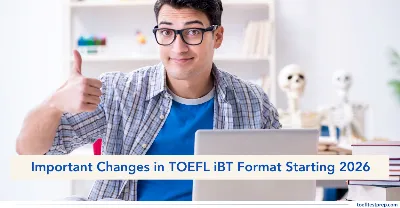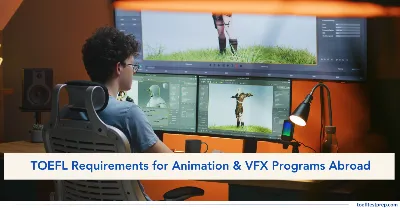Exploring the Evolution of TOEFL iBT® : Changes Over the Decades

"From its early paper-based format in the 1960s to today’s AI-powered online version, TOEFL has transformed to match global academic and career demands. Discover how each change shaped the test we know today."
Key Highlights
TOEFL has come a long way since it first began, adapting to the needs of test-takers and the global education system. From paper tests to fully digital formats, each phase brought major improvements. Understanding these changes can help learners appreciate how the test reflects real-world English skills today. It also shows how global standards in education continue to evolve. Let’s explore how TOEFL has transformed over the decades.
|
Planning to study or work abroad? |
Exploring the Evolution of TOEFL: Changes Over the Decades
Understanding how TOEFL has evolved helps students prepare more effectively for today’s version. From format shifts to skill-focused updates, the journey of TOEFL shows how language testing has kept pace with global education.
1960s to 1979 – The Original TOEFL Paper Test
- In its earliest form, TOEFL was a paper-based exam. Students answered questions about grammar, vocabulary, reading comprehension, and basic listening.
- The format was entirely multiple choice and focused on academic language understanding. There were no sections for speaking or writing.
- ETS designed the test as a general measure of English ability meant mainly for international students entering U.S. universities.
- While it provided a standard test, it did not reflect real communication skills. Students who could read and pass grammar questions might still struggle with everyday interaction.
- This version of TOEFL served its purpose at the time but had limitations in evaluating comprehensive language ability.
1979 to 1998 – Separate Speaking and Writing Tests
- Recognizing the limitations of the original format, ETS introduced two separate tests: Test of Written English (TWE) and Test of Spoken English (TSE).
- These tests were scored separately and allowed institutions to measure writing and speaking skills more accurately. Many universities began requiring them to better assess readiness.
- The TWE asked students to write essays on academic topics, testing their ability to structure ideas and use correct grammar.
- The TSE required spoken responses to prompts, simulating short oral tasks. It tested fluency, pronunciation, and organization of thought.
- These additions marked the first major shift in TOEFL format changes toward evaluating productive skills and not just comprehension.
1998 to 2005 – TOEFL Computer-Based Test (CBT)
- In 1998, the test transitioned from paper to the computer. The TOEFL CBT format introduced a new way of testing vocabulary, reading, and listening through digital delivery.
- Students typed their essay responses on the computer rather than on paper. This required good typing skills in addition to writing clarity.
- The speaking section remained separate and was not included in the main computer-based format.
- This change brought more consistency in scoring and improved logistics—students could receive results more quickly, and test administrators could manage more exams.
- The move to CBT began aligning TOEFL home preparation more closely with modern study methods that use computers and online resources.
|
Looking to fund your study abroad dreams? |
2005 to 2011 – Launch of Integrated Internet-Based Test (iBT)
- In 2005, ETS fully integrated all four skills—reading, listening, speaking, and writing—into a single test: TOEFL iBT.
- This model simulated real-life academic tasks. For example, students read a passage, listened to a lecture, and then had to speak or write a response based on both.
- Speaking tasks included summarizing spoken and written information, while writing tasks required responses to integrated or independent prompts.
- The iBT introduced a more realistic approach to testing academic English. It focused on how students used English to learn and communicate—not just how they understood it.
- This stage was a crucial point in the history of TOEFL, as it aimed to mirror the experience of studying in an English-speaking academic environment.
2011 to 2023 – Streamlined iBT Updates
- During this period, ETS made several updates to improve test efficiency and reduce fatigue. These TOEFL iBT updates focused on reducing test time while keeping standards high.
- The number of reading passages decreased from five to three or four, making the reading section more manageable. Timing across sections became more precise.
- The speaking section was reduced from six tasks to four, focusing on fluency and clarity rather than volume.
- Overall test duration dropped to about two hours. Despite shorter length, the test still required the same level of academic English proficiency.
- These changes made the test more accessible and less tiring, improving test-taker experience while maintaining credibility.
2020 and Beyond – Home Edition and New Test Versions
- In response to global shifts toward remote learning, ETS launched the TOEFL iBT Home Edition in 2020. Students could take the complete exam at home under secure online proctoring.
- Soon after, ETS introduced TOEFL Essentials, a simpler version designed for those seeking quick evaluation. Essentials offered fewer tasks and shorter duration.
- The Home Edition and Essentials options provided greater flexibility for students who needed convenience or lived far from test centers.
- These new versions allowed learners to prepare remotely and still earn a widely accepted score. It also aligned with growing trends in TOEFL for online degree programs and remote applications.
- These versions show how TOEFL is adapting to different test taker needs and global realities.
Future Outlook – Adaptive Testing and AI Integration
- Looking ahead, ETS is developing adaptive testing features for reading and listening sections. Questions will adjust in real time based on your responses, making the test more efficient and precise.
- Artificial intelligence is expected to play a larger role in scoring speaking and writing. AI tools may evaluate responses more fairly and quickly.
- Future updates may align test scores with global standards like CEFR levels. Test content will likely become even more relevant to academic and professional scenarios.
- These upcoming changes to the TOEFL format aim to create a more personalized test experience. They also reflect the move toward evaluating language skills in a way that mirrors real communication needs in study and work.
- This future phase signals how TOEFL continues evolving with technology and education demands.
The journey of TOEFL over the decades reflects how global education and communication needs have evolved. From paper-based grammar tests to flexible online formats with AI-driven scoring, TOEFL continues to adapt for today's students. By exploring the evolution of TOEFL, learners can better understand its goals and prepare more effectively for what lies ahead.
Additional Resources:
Featured Articles

TOEFL Format Undergoing Significant Changes in January 2026
The TOEFL iBT format is changing in January 2026 with a smarter structure and easier scoring. Here’s everything you need to know to stay ahead.
August 06, 2025
Minimum TOEFL Score Requirement for South Korea Student Visa
Understand the TOEFL requirement for a South Korea student visa and English-taught programs, and prepare your application for success.
September 14, 2025
Minimum TOEFL Score for Study Visa in Poland
Understand TOEFL score requirements for securing a Poland student visa and joining top universities offering English-taught programs.
September 14, 2025
TOEFL Requirements for Animation & VFX Programs Abroad
Discover TOEFL score requirements for studying Animation and VFX abroad, and learn how to meet them for top creative universities.
September 14, 2025